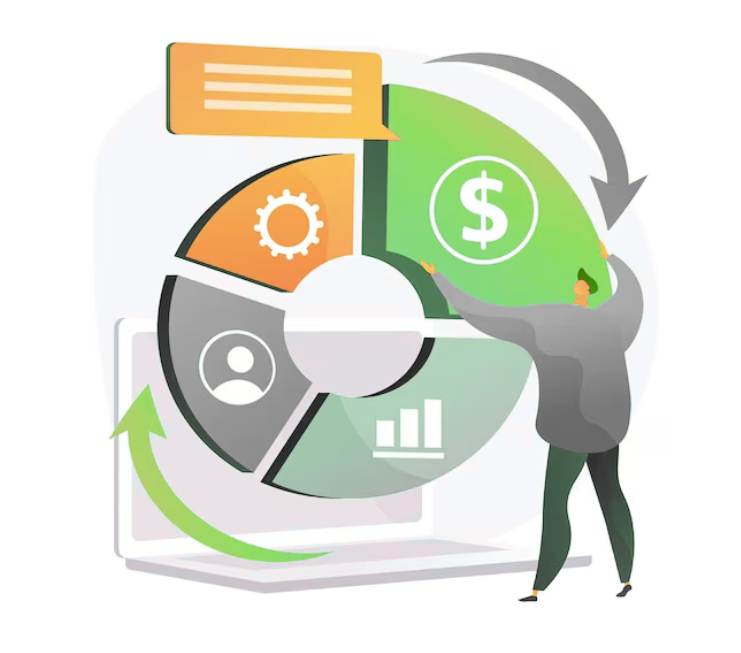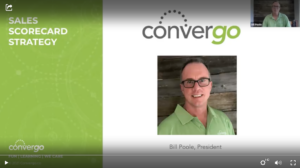
by Bill Poole | Jan 29, 2025 | Resources, Sales, Strategy
Setting sales goals is extremely important for entrepreneurial businesses. Do it right, and your entire sales team is bought into their role in delivering the needed revenue to meet the business’s goals. Do it wrong, and your goals are meaningless. Your sales team is deflated and not bought into their role in supporting the goals of the business.
Vital as it is, many teams struggle with doing this effectively. There are two high-level approaches to setting Sales Scorecard goals:
Throughout my years in sales, I’ve experienced both methods firsthand—each with its own advantages and pitfalls. In this blog, I’ll share stories from my career that illustrate the realities of both approaches. These insights can help you set your Sales Scorecard goals for 2025 with confidence.
A Story About the Top-Down Approach
I was on a sales team with seven total reps that took the top-down approach to setting Sales Scorecard goals. It started with the CFO casting a 30% YOY growth goal. Why 30%? Because that’s the growth they wanted. I call this the “spaghetti-on-the-wall” approach.
Sure, 30% growth would be nice, but the goal was based on a dream, not a plan. It had nothing to do with past performance or plans to invest in enabling that growth—it was just left to the sales reps to figure it out or work harder!
There were some advantages to this approach:
- The math was simple! Last year’s revenue x 130%, divided by 7. That sure didn’t take very long.
- The sales goals (not the people) were aligned with the business’s goals.
As you might imagine, the disadvantages in this case outweighed the advantages:
- We were not engaged in the process, so we weren’t bought into the numbers as a sales team.
- These numbers were unrealistic. We were given a significant increase in our Sales Scorecard goals without being given anything to drive the increase (new products, sales tools, more reps, etc.). Maybe they thought we would work 30% more?
- We didn’t feel like it was fair. The revenue goal was divided by seven without considering territories, skill levels, or other variables.
The result? By May, no one was on track to reach their goals. As a result, goal attainment—and the associated bonuses—were no longer a motivator. We were all focused on how we could make enough money to meet our own personal goals, and we lost visibility of the business goals, which of course fell short.
A Story About the Bottom-Up Approach
In a previous life, I was wearing a marketing hat at a technology company and learned about their bottom-up approach to setting annual Sales Scorecard goals.
The goal-setting process required gathering a lot of input from individual sales team contributors. It also took into account the macroeconomic environment, market conditions, the historical performance of the company and individual territories, and resource availability.
All these factors were considered when developing the first round of Sales Scorecard goals. Then, the company revenue goals were taken into account, resulting in an upward adjustment of the original goals.
There were some advantages to this approach:
- The sales team felt involved in setting the goals.
- Incorporating historical context into the goal-setting process ultimately made the goals more realistic and achievable than in the top-down scenario.
There were also some disadvantages to this approach:
- This was a very time-consuming process, and the goals were not communicated to reps until mid-February.
- The lack of involvement from senior leadership in the initial part of the process was risky. Though the goals seemed achievable, they could have hindered the company’s performance.
- While the process was collaborative, uplifting the goals affected the team’s buy-in of the final goals.
The result? In this case, there was buy-in, and the sales team was invested in pursuing their goals and associated bonuses throughout the year. In the end, the company fell just short of its revenue goals.
Here is a comparison of the two approaches:
| Aspect |
Top-Down |
Bottom-Up |
| Goal Ownership |
Limited for sales reps |
Strong ownership from sales teams |
| Speed of Process |
Quick and efficient |
Slower and more collaborative |
| Realism |
May overlook ground realities |
Grounded in field-level insights |
| Strategic Alignment |
Fully aligned with company vision |
May require adjustments to align |
The Answer is Somewhere in the Middle
It’s clear that neither approach is perfect, so what’s the best solution?
Instead of choosing top-down or bottom-up, the answer lies somewhere in the middle. Business goals need to be factored in, reps need to be involved, and historical data and market realities must be considered.
The keys to making this work are:
- Top-down alignment: Establish a collaborative culture where everyone is on the same page. This is broader (and more challenging) than setting annual company goals. The spaghetti-on-the-wall scenario is symptomatic of a leadership team not aligned with the rest of the company. Maintaining open and honest communication about company goals on an ongoing basis and valuing the insight of team members should be the foundation of the goal-setting process.
- Informed and action-oriented decision-making: Company leaders set annual goals based on historical data, market trends, and plans to make investments in products, tools, or strategies that will enable the desired growth.
- Sales team involvement: Start by involving the sales team as described in the bottom-up approach.
- Collaboration: Once the goals have been set, let the sales leadership go to work! With everyone on the same page in this collaborative culture, the role of the sales leader is to coach the reps and team to collaborate on a Sales Scorecard that will support the business goals.
This approach balances ambition with practicality, fostering buy-in across the organization while ensuring alignment with the big picture. It may take longer than the top-down approach, but start earlier! The result is that everyone will be aligned and invested in reaching their goals as a team.
Need Help Setting Your Sales Scorecard Goals?
Convergo is rolling out our Sales Scorecard Workshop to help teams get this right. Stay tuned for details, or contact us today to start the conversation!

by Bill Poole | Aug 9, 2023 | Resources, Sales
Creating a business plan (V/TO™) is a great first step in moving your business to your goals.
Putting in place the processes and metrics to enable you to meet those business goals is a journey, but it is a journey worth taking. We call this the “Connected Scorecard.” The connected scorecard tracks the right activity metrics to drive your desired lagging metrics (your desired results from your Business Plan/ V/TO). Tracking the right leading metrics between the two helps you know if you are getting there.
Once you have the right processes in place and track the right metrics, you know how to take the appropriate actions to move your business forward.
Check out the video on how to Connect Your Sales Scorecard to Your Business Plan.

Connect Your Sales Scorecard

by Bill Poole | Apr 11, 2022 | Marketing, Resources
Much has been said about the Hubspot Buyer’s Journey Simply stated, the buyer’s journey is the process that a buyer goes through in making a decision to buy. Hubspot’s definition: The buyer’s journey describes a buyer’s path to purchase. In other words, buyers don’t wake up and decide to buy on a whim. They go through a process to become aware of, consider and evaluate, and decide to purchase a new product or service.
There are 3 stages in the Hubspot Buyer’s Journey:
- Awareness Stage: buyers become aware they have a problem.
- Consideration Stage: The buyer defines the problem and considers options to fix it.
- Decision Stage: buyer evaluates and decides on the right provider to administer the solution.
Here is an example of a buyer’s experience that I had:
- Awareness: I value my sleep, but some nights I sleep better than others. What can I do to fix that?
- Consideration: What are some different things I can do to improve my sleep? Eat earlier? Ensure I exercise daily? Have a glass of wine in the evenings? Have 2 glasses of wine? Maybe I shouldn’t have wine at all? Wow, what can I do to know what works and what doesn’t? I think the first step is to find something that can give me some data to help me! I don’t particularly like wearing a watch, but there are watches that can monitor my sleep with data.
- Decision: Given my phone has everything I need on it, and I don’t like wearing accessories, my decision is based on finding the simplest watch that has the app that best tracks my sleep. I landed on a simple version of the Apple Watch.
What a great framework for a B to C marketing professional to align with in order to sell more to their target persona!
Leveraging the buyer’s journey for a B to B services decision is a bit more complicated. Decisions in this environment are more complex, involve more decision-makers, and are typically long-term engagements.
Then how can a B to B services organization leverage the buyer’s journey decision-making psychology? Ideal Client Experience is the perfect framework.
The rest of this blog will take a look at how an Ideal Client Experience is an effective framework to manage decisions that:
- Involve multiple Stakeholders
- Are more complex
- Are typically long-term decisions with the opportunity to expand the services.
Before we do that, let’s remember one fundamental difference in B2B organizations and that is that there is a significantly higher investment in sales than there is in a B2C organization. In B2B, marketing is fundamental to the Awareness stage, but then the sales reps do the heavy lifting from there. On the other hand, despite arguably retail, sales reps do not even exist in many B2C organizations.
Multiple Stakeholders
The fact that there are multiple stakeholders means that there are multiple people going through their own buyer’s journey. A properly crafted Ideal Client Experience includes strategies to engage and leverage the buyer’s journey for all stakeholders involved in a decision given the nature of the service.
For example, a decision for a CRM typically involves sales and marketing or at least it should be given there ought to be alignment and visibility between sales and marketing. That said, it would never be implemented without a “yes” from IT and finance.
Given this decision is typically initiated by sales or marketing, the primary message is typically crafted around their goals and challenges. However the Ideal Client Experience needs to include strategies to engage with all of the key stakeholders and help them navigate their buyer’s journey.
More Complex Decisions
In addition to including multiple stakeholders, B to B services decisions are much more complex, especially when the business has a strong value proposition. The challenges that are addressed are typically much more comprehensive and complicated.
Structuring the part of the Ideal Client Experience that aligns with the Consideration and Decision stages of the buyer’s journey ensures that:
- The impact of all challenges are explored in the needs assessment phase.
- The business outcomes are properly communicated in the proposal phase.
The Outcomes Inventory is a great framework for this. 3 high-level outcomes that a CRM would deliver should be:
- Revenue Growth
- Client Satisfaction
- Sales, marketing, and IT efficiency
The Assessment part of the Ideal Client Experience should be highly structured with an objective process to show how these 3 outcomes are being affected by the current situation. Then, the proposal should clearly state how the future vision/proposal will impact these outcomes.
Having a repeatable, objective process inside of the Ideal Client Experience helps make a complex decision simple by connecting the complexity to the business outcomes.
Expanding Services
B2C decisions typically have more limited opportunities to create future revenue streams. I also suppose items with consumables (water filters) are somewhat of an exception. I assume my Apple Watch decision might lead to additional Apple products, but the opportunity for future revenue in services organizations can be HUGE. This part of the Ideal Client Experience goes beyond the traditional buyer’s journey as we know it.
For a B2B services organization, the signing of the initial contract is just the beginning from 2 perspectives:
- Onboarding – The need to create a very positive initial experience to manage change in the client organization and offset buyer’s remorse.
- Client Success – The opportunity to increase value for the client by expanding/cross-selling services.
So, the Ideal Client Experience needs to be structured to ensure a smooth transition and position the business to expand services.

Onboarding
As Joey Coleman says, “Buyers decide in the first 100 days whether they will continue to do business with you or not.” Treating the onboarding process distinctly different from the process to deliver ongoing services is critical to the success of a services engagement. A change management strategy is critical in turning client satisfaction in this stage into long-term client loyalty.
Client Success
With many organizations, when the contract is signed, the client is turned over to operations while the sales reps turn their focus to finding more clients. No matter how good an organization is from an operational perspective, the possibility for expansion of services is limited.
Both sales and operations are critical in this stage to expand services to drive revenue growth. Integrated into this stage must be a framework for:
- Staying connected with the client’s business, their goals, and their challenges.
- Reinforcing the value being delivered in the current engagement.
- Creating additional value for the client via expanding services.
In the end, Ideal Client Experience is a fantastic framework to leverage the buyer’s journey for differentiating, driving additional client value, and increasing revenue.

by Bill Poole | Feb 24, 2022 | Marketing, Resources
Every growing business needs a stream of leads from ideal prospects. One way to create leads is with lead magnets.
A lead magnet is information of value to a prospect that captures their attention and motivates them to exchange contact information.
In Revenue Growth Engine I highlight the problem of the filter. In today’s world, buyers are subjected to thousands of messages each day. Advertisements, email, and social platforms all compete for attention. We have adapted (survived!) by filtering out everything except for one thing: ideas that are valuable to us.
The only thing that gets through the filter are ideas that are related to the outcomes we want to achieve. These can include ideas and answers related goals we have or problems we want solved.
A Lead Magnet Example: My Trek To Mount Everest Base Camp
For example, I am currently training to go on a trek to Mount Everest Base Camp. This has opened up a long list of questions for me:
– What kind of jacket do I need to buy?
– What do I need to do to train?
– How can I avoid mountain sickness?
All of these questions and more are on my radar. As I go about my day, I successfully filter out thousands of messages. But as you can guess, an email that comes in about “The 10 Best Jackets for Severe Mountain Environments” or a social post about “How To Train to Hike at Elevation” will catch my eye. Furthermore, I’m spending time on Google almost every day searching for answers to these questions.
Let’s consider my concerns about training to hike at 18,500 feet. You’ve probably heard of “The couch to 5K.” I needed to do a dad-bod-office-jockey to 18.5K mountain man in less than 120 days. The outcome that I want is to get to Mount Everest Base Camp without the Sherpas having to call a helicopter in because I can’t keep up. I want to avoid being injured. At a more emotional level, I want to avoid being embarrassed in the eyes of my family, friends, and colleagues who know I’m going on this trek.
When it comes to solutions to my problem there are plenty of companies offering personal training, diet plans, and supplements. A smart company understands my real need isn’t for these products. My radar is attuned to ideas that will help me achieve my outcome of successfully getting to my mountain destination without embarrassing or hurting myself!
A smart company creates a lead magnet that captures my attention by addressing the outcomes I want. While looking for answers to my dilemma, I found a guide titled something like this: “How New Hikers Can Train For a Mountain Trek At High Elevation—Without Getting Hurt or Embarrassing Themselves.”
I saw this on the web during one of my searches. In exchange for my email address, they sent the lead magnet to me. Of course, the company that offered the advice also sells personal training plans, diet plans, and supplements. Since downloading the report they have made these offers to me by email. I also recognize their offers through retargeting ads that I see in Google ads, social ads, and YouTube ads. It’s not surprising that I reached out for a consultation with their trainer.
Characteristics of an Effective Lead Magnet
How can this apply to your business? Here are a few key characteristics of an effective lead magnet.
1. Must be related to the outcomes your prospects want
The lead magnet needs to be focused on the specific goals your prospect have and/or the problems they encounter hitting these goals. Information about anything else simply will not get through their filter.
How do you find out what’s important to your prospects? Pay attention. Listen to your best clients. Watch the trends of the economy and the industry you serve. Change is the one constant in our world. Any time there is change, there are problems. Focus your lead magnets on these types of topics.
Pay specific attention to the title or headline of your lead magnet. Be focused and specific. This is what will capture the prospect’s attention.
2. Must be useful enough for the prospect to give you contact information
The information needs to be useful enough for the prospect to give you contact information. You don’t have to give away a book. (Although, this is exactly what we do. You can get a free copy of Revenue Growth Engine by clicking here.) You do need to give away something substantial enough for someone to give you their contact information. This could be a special report, an ebook, a webinar recording, or an online course.
Remember, your offer may be free but in the eyes of the prospect it is not completely free. You are asking the prospect to give their contact information and a piece of their privacy in exchange for the information. This contact information has value to both you and the prospect. It’s important to remember this when you are creating your offer.
Fortunately, these days prospects know they can unsubscribe from email lists. While this has confounded many marketers, I think it actually helps boost conversion rates when someone knows that they can opt out if they get hammered by emails after filling out a form.
What Lead Magnets Could You Create?
Lead magnets can be used in all of your top-of-funnel activities. They can become calls-to-action on your website and blog. They can be served up in paid advertising to targeted audiences on Google and social platforms. They can be shared by salespeople.
To get started, think of the top 5 goals and/or challenges your clients face. (If you don’t know, ask!) Then begin brainstorming titles for content that answers those questions. This creates a menu of ideas from which you can build special reports, guides, webinars, live streams, checklists, and all types of lead magnets that will break through your prospects’ filters and generate leads.
Part of what we do at Convergo is help companies create a Focused Message Plan. This is a strategic approach to understanding the desired outcomes of each decision maker and influencer in your Ideal Prospects. This helps ensure that your company has helpful and relevant information to not only create leads but guide buyers through the entire journey of becoming a 100% sold client.
To learn more about how Convergo could help you create a Focused Message Plan and effective Lead Magnets schedule your complimentary explore meeting.


by Bill Poole | Feb 1, 2022 | Resources, Sales
Originally posted by Darrell Amy on LinkedIn.
When it comes to revenue growth, most companies focus on the total revenue goal. Doing this usually ignores a critical driver of revenue: cross-sell revenue. The goal for cross-sell should be 100% sold.
Most companies do a reasonable job at landing new clients. The majority of companies struggle at expanding inside their base. With marketing focused on generating leads and sales focused on closing net-new business we have a tendency to land new deals and then walk away.
My first real sales job was with a company that drilled into my head the concept of 100% sold. A client becomes 100% sold when they are taking advantage of all of the products and services your company offers. As marketing guru Jay Abraham would say, “You want all of our clients to get the best and highest value from your company.”
100% Sold: What percentage of your clients own all of your products and services?
As I lead Revenue Growth Workshops across multiple industries the common trend is that companies tend to focus expectations on marketing and selling their core product. Little attention gets placed on new products and supporting offerings.
Too many companies have only paid lip-service to cross-selling more products and services to their current client base. As a result, low-hanging fruit sits rotting on the vine. Even worse, smart competitors that grab that fruit can use their relationship with your customer to displace you from the account.
100% sold should be tracked on three levels:
1. Company Wide
What percentage of your client base owns each of your product and/or service categories? You may have a core product that 100% of your clients own. Then, you may have a service offering that 25% of your clients own. You may have a secondary product offering that 10% of your clients own. Company dashboards should include the percent of clients that own each of your products. 100% sold should be a topic in every company meeting.
2. By Sales Rep
How well is each rep doing at 100% sold across their client base? Measuring reps by the percentage of their clients that use each product and service keeps the focus on cross-selling. If a given rep is underperforming in selling a product or service category their development plan can include learning how to sell that service. Bonus structures can be configured based on 100% sold metrics. Stack rankings can be presented by 100% sold.
3. By Client
For any given client, what percentage of your product and services offering do they own? If you have four lines of business and your client only has one line, they are 25% sold. They may be a big client for that one line of business but they are still only using 25% of your products and services. Account reviews with marketing (yes, I said marketing) and sales can include developing strategies to get to 100% sold. This is especially fruitful for your Ideal Clients.
How To Get To 100% Sold
It’s time to get serious about cross-selling. In Revenue Growth Engine I present marketing and sales processes that can be leveraged to cross-sell. There are many processes you can build to align marketing and sales around this goal.
The first step, however, is to set the goal of 100% sold and track the progress. Whether you own a company, lead a revenue team, or work in sales, you can put this to work right away.
Executives
Get your copy of Revenue Growth Engine. In the book, I unpack the concept of 100% sold and offer key marketing and sales processes you can put into place to maximize revenue by driving toward 100% sold.
Sales Leaders
Develop the account management sales skills to drive 100% sold with the Authentic Client Management program, part of the Trust-Building Series from Selling From the Heart.
Sales Professionals
You don’t have to wait for your company to set your own 100% sold goals and build the skills to execute. Join the Client Management part of the Trust-Building INTENSIVE from Selling From the Heart to begin enjoying the low-hanging fruits of 100% sold.


by Lisa Dalton | Dec 21, 2020 | Resources
You may be a new manager, someone people come to for advice, or a seasoned manager looking for some new tips to help employees. Coaching is a great skill to have on your toolbelt, but how do you do it and which model should you use?
There are many coaching methods out there – GROW, TGROW, OSKAR, CLEAR to name a few. I am partial to GROW, created in the late 80s by Graham Alexander, Alan Fine, and Sir John Whitmore and influenced by Timothy Gallwey. It is probably the model most recognized; it’s simple to understand, easy to use and it works!
Coaching is a skill and with most skills there is a method to the madness. It will take some practice, but with GROW you can literally do a quick reading or watch a video and start coaching. You can use GROW to coach others as well as yourself – just follow the model. And if you really want to do a deep dive, get Coaching for Performance.
So what is the GROW coaching model?
There are 4 parts to the model: goals, reality, options, and choosing what to do.
Goal
The G stands for Goal and is all about the coachee setting a goal. The coachee owns the goal, not the coach. What does the coachee want to achieve? The coach helps the coachee to make sure they have a SMART (specific, measurable, achievable, realistic and timebound) goal.
Reality
The R stands for Reality or Current Reality – what is happening now? Peel the onion back and really understand what is going on. This is truly the heart of the matter and typically takes the most amount of time in the coaching session. Often, the coachee realizes what has gotten in their way and how to get on track.
Options
The O stands for Options. What can the coachee DO to achieve their goal? What options do they have? It is important to take off any blinders in this part of coaching – the sky’s the limit. It is a real brainstorming session. Let the coachee think and talk. Make a list of all of the options. As a the coach, don’t offer any ideas until the coachee has had some time to think and come up with a list of options. Only when the coachee has finished brainstorming AND agreed to hearing other suggestions should you provide your suggestions. On the rare occasion a coachee may not have any idea what to do, but that is rare.
What Will You Do?
The W stands for What Will You Do? Based on the options provided, what is the most powerful step the coachee can take to move towards the goal? Sometimes a coachee will want to action a few options which is great, but help the coachee prioritize the options. Once the options have been prioritized, ask the coachee when they will take action on the chosen option. The time has to be specific. Then ask how committed the coachee is to taking the action on a scale of 1-10, 10 being it is going to be done! Do not let the coachee walk away with any actions under a 10. If they can’t commit to a 10, see how the action can be changed so that the coachee can commit to taking action with a commitment of 10.
I have found coaching to be an incredibly rewarding activity for both the coach and coachee. Create a cheatsheet and don’t hesitate to use it.









